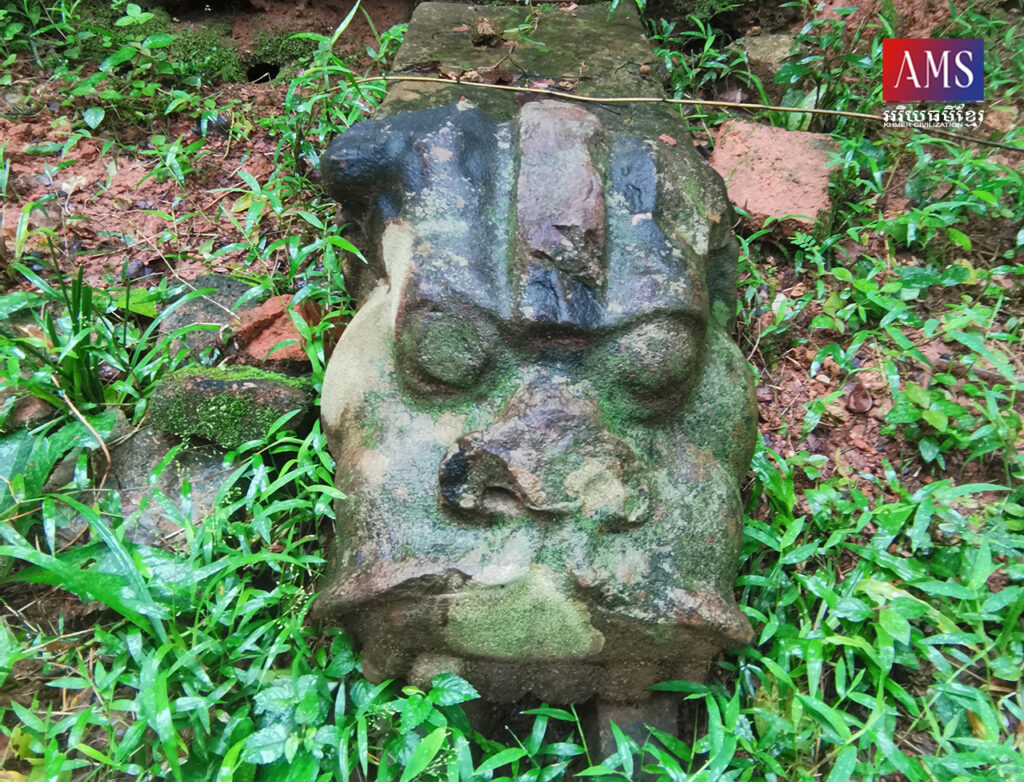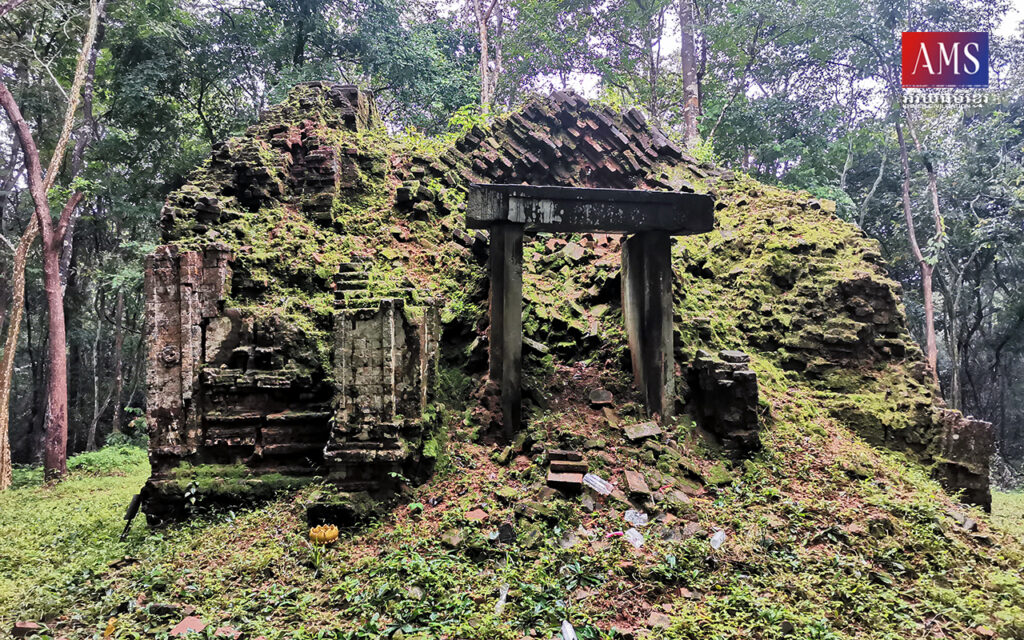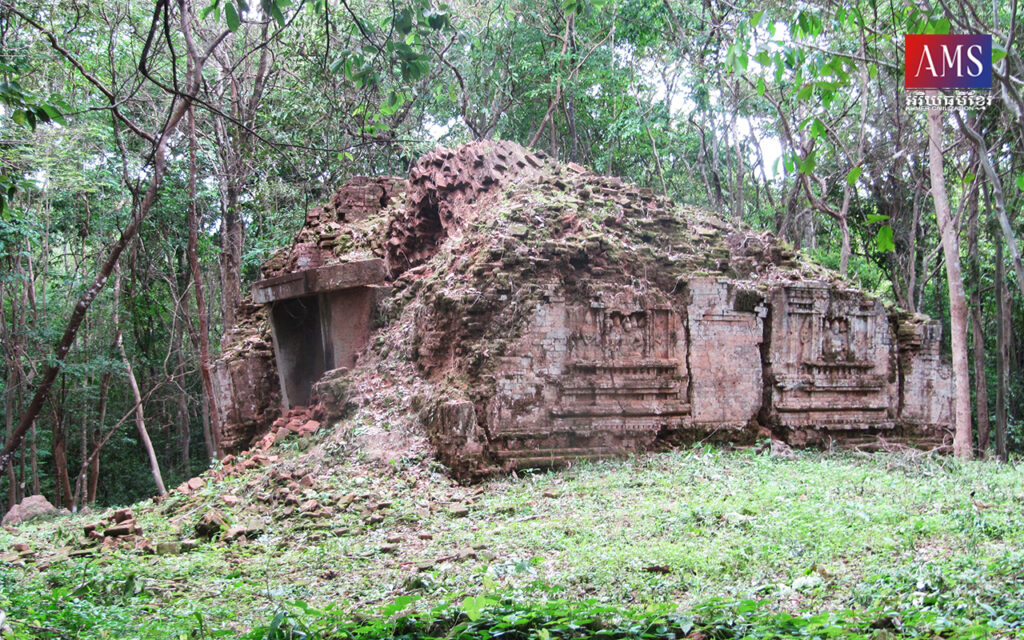ប្រាសាទក្បាលជ្រូក គឺជាឈ្មោះប្រាសាទមួយដែលស្ថិតនៅក្នុងក្រុមប្រាសាទសំបូរ ឬក្រុមខាងជើង នៃតំបន់ប្រាសាទសំបូរព្រៃគុក ចុះបញ្ជីលេខ N20-1, N20-2, N20-3។ ប្រាសាទនេះ ស្ថិតនៅទិសឦសានតួប៉មកណ្តាល N1 ហើយស្ថិតនៅខាងក្រៅកសិន្ធុទឹកនៃក្រុមប្រាសាទសំបូរ។
ឈ្មោះ “ក្បាលជ្រូក” ទំនងជាឈ្មោះដែលអ្នកស្រុកហៅសំដៅលើចម្លាក់ក្បាលមករដែលយើងឃើញនៅផ្នែកខាងជើងនៃប្រាសាទ N20-1 ដ្បិតអ្នកស្រុកមិនស្គាល់ចម្លាក់នោះថាជាសត្វមករ ក៏បែរជាហៅថា “ក្បាលជ្រូក” ដូច្នេះទៅ។ ដោយឡែក យោងតាមសិលាចារឹកដែលចារឹកនៅលើមេទ្វាររបស់ប្រាសាទផ្តល់ព័ត៌មានឱ្យដឹងថា ទេពសំខាន់មួយរបស់ប្រាសាទមានព្រះនាមថា “ឝ្រីប្រភាសោមេឝ្វរ” (Çrīprabhāsomeçvara) ដែលយើងអាចសន្និដ្ឋានថា ព្រះនាមទេពនេះ អាចជាឈ្មោះដើមរបស់ប្រាសាទ។
ប្រាសាទក្បាលជ្រូក មានតួប៉មចំនួន ៣ ប៉ុន្តែសព្វថ្ងៃមានតែតួប៉ម N20-1 ប៉ុណ្ណោះ ដែលនៅសល់រូបរាង ដ្បិតតួប៉មចំនួនពីរទៀតបានបាក់បែកក្លាយជាទួលទៅហើយ។ តួប៉មដែលនៅសល់រូបរាងសាងឡើងអំពីឥដ្ឋ មានរាងបួនជ្រុងទ្រវែង បែរមុខទៅទិសខាងកើត។ ផ្នែកដំបូលរបស់តួប៉មនេះសព្វថ្ងៃបានបាក់បែកទាំងស្រុង ហើយពំនូកគំនរឥដ្ឋបានធ្លាក់ចូលតួខាងក្នុងប្រាសាទកប់បាត់តែម្តង។ ក្រៅពីច្រកចូលនៅទិសខាងកើត ផ្នែកមុខបីផ្សេងទៀតនៃតួប៉មនេះពុំមានលម្អជាទ្វាបញ្ឆោតទេ។ នៅអមសងខាងច្រកចូលខាងកើត សិល្បករលម្អជាសសរផ្អោបដែលមានក្បាច់ផ្កាច័ន្ទ ហើយនៅក្បែរសសរផ្អោបលម្អជាវិមានអណ្តែតនៅមុខខាងកើតចំនួនពីរ។
រីឯជញ្ជាំងនៅមុខខាងលិចក៏លម្អជាសសរផ្អោបនិងវិមានអណ្តែតចំនួនពីរដូចគ្នាដែរ។ នៅជញ្ជាំងខាងជើង និងត្បូង មានរាងទ្រវែង សិល្បករពុំមានលម្អជាក្បាច់អ្វីទេនៅផ្នែកកណ្តាលជញ្ជាំង ហើយនៅសងខាងជញ្ជាំងកណ្តាលគេលម្អជាវិមានអណ្តែតចំនួនពីរ។ ចម្លាក់វិមានអណ្តែតនៅតួប៉មនេះ សិល្បករឆ្លាក់ចេញជាបីថ្នាក់ដូចនៅតួប៉មផ្សេងៗទៀតដែរ ដែលថ្នាក់ខាងក្រោមជាខឿនមានលម្អដោយក្បាច់ពងត្រី រុក្ខជាតិ ជើងទៀន ហើយខ្លះក៏មានឆ្លាក់ជារូបមនុស្សឬទេពនៅចំកណ្តាល ផ្នែកកណ្តាលមានឆ្លាក់រូបមនុស្សឬទេពនៅចន្លោះខាងក្នុងក្បាច់សសរផ្អោបដែលខាងលើមានផ្តែរទ្វារឆ្លាក់រូបមករកណ្តាលមានក្បាច់រាងរង្វង់ និងផ្នែកខាងលើមានឆ្លាក់ជាហោជាងមានលម្អរូបមនុស្សឬទេពនៅខាងក្នុង ហើយនៅខាងចុងមានចម្លាក់សត្វមករមានខ្លួនជាសត្វក្រពើមានទេពជិះពីលើ។ ចម្លាក់មួយនៅផ្នែកខាងជើងត្រង់កណ្តាលមានរូបទេពប្រុសមួយអង្គអង្គុយក្នុងរបៀប Rājalīlāsana ពាក់ក្បាំងនៅលើក្បាល ស្លឹកត្រចៀកវែង ទំនងទេពសំខាន់ណាមួយ។ ក្បាច់លម្អជាទូទៅរបស់ប្រាសាទក្បាលជ្រូក N20-1 មានទម្រង់ស្រដៀងនឹងក្បាច់នៅប្រាសាទជ្រៃ ប្រាសាទស្រង់ព្រះ ដែលស្ថិតនៅក្នុងក្រុមប្រាសាទសំបូរ ឬក្រុមខាងជើងតែមួយ ហើយមានទម្រង់ជាសិល្បៈរចនាបថព្រៃក្មេង។
នៅមេទ្វារខាងកើតទាំងសងខាងមានសិលាចារឹកចុះបញ្ជីលេខ K.439 ចារជាភាសាសំស្រ្កឹតដែលមេទ្វារខាងត្បូងមានចំនួន២០បន្ទាត់ (១០ស្លោក) និងខាងជើងមានចំនួន១៨បន្ទាត់ (៩ស្លោក) ប៉ុន្តែតួអក្សរភាគច្រើនរបេះថ្មរលុបច្រើនធ្វើឱ្យបាត់ព័ត៌មានច្រើន។ សិលាចារឹកនៅខាងត្បូងរៀបរាប់អំពីព្រះបាទភវវរ្ម័នទី២ ទ្រង់ធ្វើដង្វាយអ្នកបម្រើប្រុសចំនួនពីរ ដែលក្នុងនោះម្នាក់ឈ្មោះ សមុទ្រគុប្ត (Samudragupta) ហើយដោយសារមានការបាត់បង់អក្សរច្រើនគេពុំដឹងរឿងរ៉ាវក្នុងសិលាចារឹកនេះបន្តទៀតយ៉ាងណាទេ ប៉ុន្តែគេដឹងថាវាមានទំនាក់ទំនងជាមួយអទិទេព ឝ្រីកំម្ភីរេឝ្វរ (Çrīkaṃmbhĭreçvara) ដែលជាអទិទេពដ៏សំខាន់នៅក្រុមប្រាសាទសំបូរតែម្តង។ ចំណែកសិលាចារឹកនៅមេទ្វារខាងជើងវិញរៀបរាប់អំពី ភាពក្លាហានរបស់ព្រះបាទជ័យវរ្ម័នទី១ ដែលត្រូវជាចៅប្រុសព្រះបាទឦសានវរ្ម័នទី១ទ្រង់ បានសាងសង់លិង្គធ្វើអំពីមាសតម្កល់នៅតួប៉មនេះមានឈ្មោះថា ឝ្រីប្រភាសោមេឝ្វរ (Çrīprabhāsomeçvara) និងមានស្រ្តីម្នាក់ដែលទំនងជាមហេសីរបស់ព្រះរាជាថ្វាយដង្វាយជាប្រាក់ សំរិទ្ធ ទង់ដែង ដីស្រែ គោក្របី ថ្វាយដល់ព្រះអទិទេពដែលមានព្រាហ្មណ៍ម្នាក់ឈ្មោះ រុទ្រភក្ទីរ (Rudrabhaktir) ជាអ្នកចាត់ចែងពិធី ហើយនៅបន្ទាត់ចុងក្រោយជាបណ្តាសា បើមានជនណាមានចិត្តលោភលន់ចង់កេងប្រវ័ញ្ចទ្រព្យសម្បត្តិទាំងនេះ សូមឱ្យធ្លាក់នរកទាំងពូជ ដរាបណាផែនដីរលាយ។ សិលាចារឹកទាំងនេះ គឺជាព័ត៌មានដ៏សំខាន់បញ្ជាក់អំពីព្រះនាមព្រះបាទភវវរ្ម័នទី២ និងព្រះបាទជ័យវរ្ម័នទី១ ដែលបានបន្តសាងសង់ប្រាសាទនៅក្នុងតំបន់ប្រាសាទសំបូរព្រៃគុក ដ្បិតសិលាចារឹកជាង២០ផ្ទាំងដែលរកឃើញនៅសំបូរព្រៃគុក ភាគច្រើនរៀបរាប់តែព្រះបាទឦសានវរ្ម័នទី១ និងស្តេចចេនឡាដំបូងៗ ហើយកម្រមានសិលាចារឹកណាដែលរៀបរាប់ពីព្រះបាទភវវរ្ម័នទី២ និងជ័យវរ្ម័នទី១ឡើយ។ នៅក្នុងរជ្ជកាលរបស់ព្រះបាទភវវរ្ម័នទី២ ពុំសូវមានសិលាចារឹករៀបរាប់អំពីទ្រង់ទេ ប៉ុន្តែមានសិលាចារឹកចំនួនពីរដែលបានប្រាប់ឱ្យដឹងថា ទ្រង់ គឺជាបុត្ររបស់ព្រះបាទឦសានវរ្ម័នទី១ ពោល គឺសិលាចារឹក K.506 និង K.1150។ លោក ម៉ៃឃើល វីឃីរី សន្និដ្ឋានថា ព្រះបាទភវវរ្ម័នទី២ ទំនងបន្តសោយរាជ្យនៅតំបន់សំបូរព្រៃគុក ប៉ុន្តែព្រះរាជាបន្ទាប់ គឺព្រះបាទជ័យវរ្ម័នទី១ ដែលត្រូវជាព្រះរាជនត្តារបស់ព្រះបាទឦសានវរ្ម័នទី១ បានផ្លាស់រាជធានីទៅជិតតំបន់អង្គរ។
ជារួមមក តាមការរៀបរាប់អំពីក្បាច់លម្អស្ថាបត្យកម្ម និងសិលាចារឹករួចមក យើងអាចសន្និដ្ឋានថា ប្រាសាទក្បាលជ្រូក ទំនងកសាងឡើងនៅស.វ.ទី៧ ក្នុងរជ្ជកាលព្រះបាទភវវរ្ម័នទី២ ហើយអាចបន្ថែមខ្លះក្នុងរជ្ជកាលព្រះបាទជ័យវរ្ម័នទី១ ដែលស្ថិតនៅក្នុងរចនាបថព្រៃក្មេង ឧទ្ទិសដល់ព្រហ្មញ្ញសាសនា និកាយព្រះឥសូរ។
——————————
Kbal Chrouk Temple in Sambo Prei Kuk (Tower N20)
Kbal Chrouk Temple is the name of a temple which is in the group of Sambor temples or the northern group of Sambor Prei Kuk temple complex, registration number N20-1, N20-2, N20-3. The temple is located northeast of central tower N1 and is located outside the bank of the Sambo temple complex.
The name “Kbal Chrouk” is likely to refer to the sculpture we see on the north side of the N20-1 temple, as locals do not recognize the sculpture as a Makara, so they call it “Kbal Chrouk”. According to the inscription on the main door of the temple, one of the main deities of the temple is named “Çrīprabhāsomeçvara”, which we can assume that the name of the deity is probably the original name of the temple.
Kbal Chrouk temple has three towers, but today only the N20-1 tower remains, as the other two towers have collapsed. The remaining brick towers are rectangular, facing east. Whereas, the four corners of the wall are adorned with pillars and two flying palaces. The flying palaces in the tower are carved in three tiers, with the lower level adorned with ovals, plants, candles supporter, and some carved in the center of a human or deity. The lintel is carved as Makara at the center and has a circular decoration. The pediment is adorned with a human or deity inside, and at the end is a Makara containing as a crocodile body with a deity riding on it. A sculpture in the north-central center depicts a male deity sitting in the Rājalīlāsana style, wearing a veil over the head, long ears, likely an important deity. The general ornaments of Kbal Chrouk N20-1 are similar in style to those at Prasat Chrey, Prasat Srong Preah, which belong to the Prasat Sambor or northern group, and within Prei Khmeng style.
On both sides of the east main door are inscriptions K.439 inscribed in Sanskrit, the south main door has 20 lines and the north gate has 18 lines, but most of the characters are broken, lead to losing a lot of information. An inscription on the south depicts Bhavavarman II offering two servants, one of whom was Samudragupta, and due to the loss of many letters in an inscription, thus its information is still unknown. But it is known to be related to the goddess “Çrīkaṃmbhĭreçvara”, the main deity in the Sambo temple complex.
These inscriptions are important information confirming the names of Bhavavarman II and Jayavarman I, who continued to build temples in the area of Sambor Prei Kuk, as more than 20 inscriptions found in Sambor Prei Kuk mostly describe Isanvarman I and Chenla first, and there are rarely any inscriptions describing Bhavavarman II and Jayavarman I. During the reign of Bhavavarman II, there are no inscriptions describing him, but there are two inscriptions indicated that he was the son of Isanvarman I, K.506 and K. 1150. Michael Vicky concludes that Bhavavarman II was likely to continue to reign in the Sambor Prei Kuk complex, but the next king, Jayavarman I, who was the son-in-law of Isanvarman I, moved the capital closer to Angkor complex.
Overall, from the descriptions of the architectural ornaments and inscriptions, we can conclude that Kbal Chrouk temple was probably built in the 7th century during the reign of Bhavavarman II and probably add some during the reign of Jayavarman I, which is in the style of Prei Khmeng dedicated to the Hindu religion.
អត្ថបទដើម៖ លោក ម៉ង់ វ៉ាលី










